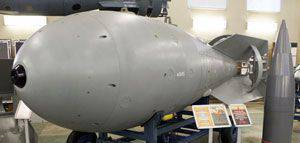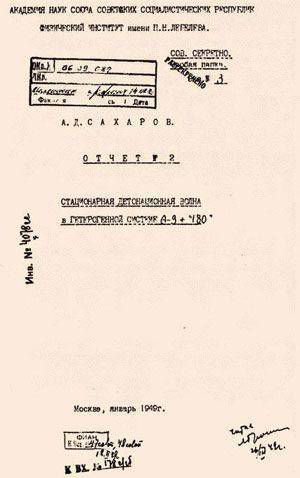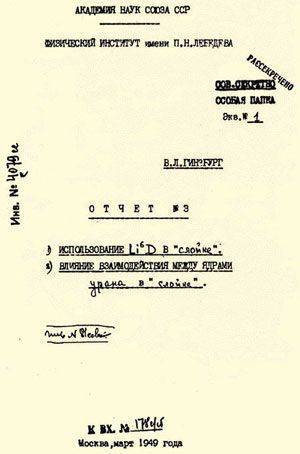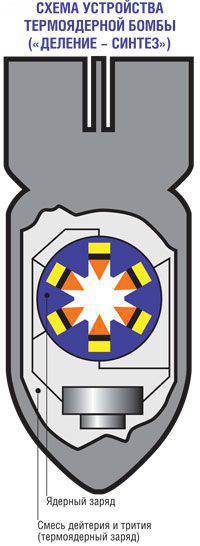Overbomb
It is known from published archival documents that in the initial period of the Soviet Atomic Project, two versions of the hydrogen bomb (WB) were developed: a “pipe” (RDS-6T) and a “puff” (RDS-6С). The names to a certain extent corresponded to their constructive structure.
The Yakov Zeldovich group at the Institute of Chemical Physics (ICP), and then the scientists of Laboratory No. 3 and Laboratory B, carried out calculations of the WB RDS-6T in the form of a thin-walled cylinder with a diameter of 50 centimeters and a length of at least five meters filled with liquid deuterium in quantities of 140 kilograms. According to calculations, the explosion of this mass of deuterium is equivalent to one to two million tons of TNT. An atomic bomb in a cannon version is used to initiate an explosion. Between the charge of uranium-235 and deuterium is an additional detonator from a mixture of deuterium and tritium, which reacts faster and at a lower temperature than pure deuterium. The entire system is thermally insulated so that liquid deuterium does not evaporate during transportation. Even from this description, presented by Yakov Zeldovich in the note “Hydrogen Deuterium Bomb” in February 1950, it can be seen that the implementation of the WB RDS-6Т with liquid hydrogen turned out to be associated with great technical difficulties.
The advantage of the "puff"
Igor Tamm, Yakov Zeldovich and Andrei Sakharov indicated in their report “Model of the RDS-6C product” for 1953 that the thermonuclear reaction in deuterium proceeds at the speed required for an explosion only at extremely high temperatures and has not yet proved the practical possibility to maintain them.
Due to the negative results of many years of theoretical calculations carried out, work on the WB RDS-6T was discontinued by the decision of the MSM management of the USSR in the 1954 year.
The decision to create a WB in the form of alternating layers of fissile material and thermonuclear components (hence the “puff”) was proposed by Andrei Sakharov, an employee of the theoretical department of the Physics Institute of the Academy of Sciences (FIAN), headed by Igor Tamm. 2 December 1948 of the year at a meeting of the Scientific and Technical Council (STC) of Laboratory No. 2 held a discussion of the reports of Zeldovich and Tamm on the results of studying the use of the reaction of light nuclei synthesis to create WB of various design schemes.
The minutes of the NTS meeting indicated that the council considered interesting the results of both groups, but especially the system in the form of a column of heavy water and А-9 (symbol of natural uranium), which according to preliminary calculations can detonate when the diameter of the column is about 400 millimeters. The advantage of this system is the possibility of using heavy water instead of deuterium, which eliminates the need to deal with hydrogen at low temperatures.
The decision of the NTS Laboratory No. 2 1948 of the year indicated the need to concentrate the work of Tamm's group on Sakharov's proposal and conduct experiments at FIAN in the team of Ilya Frank to study neutron multiplication in the heavy water-uranium system, freeing the team of scientists from other works.
The results of this review, Igor Kurchatov and Yuli Khariton, reported to Boris Vannikov, Chief of the First Main Directorate (PSU) under the Council of Ministers (SM) of the USSR, attaching a draft resolution of the USSR Council of Ministers, prepared on the basis of a decision of the NTS.
The discussion at the scientific seminar of the Laboratory No. 2 of the reports of Zeldovich and Tamm served as the basis for the broad development of theoretical and experimental work on the creation of the first Russian hydrogen bomb.
Paradise for theorists
WB RDS-6С in official documents was called a product, only sometimes using the true name. The RDS-6C is arranged as follows: in the center of the system of alternating layers of natural uranium and light material consisting of a mixture of deuteride and lithium-6 tritide, a charge of uranium-235 is placed. The surface of the "puff" consists of an explosive (EX) to initiate an explosion of a nuclear (uranium-235) charge, which causes a powerful flow of energy in the form of neutrons, quanta and other particles. This leads to ionization heating (compression) to stellar temperatures of a thin layer of thermonuclear fuel and a layer of uranium. The latter then turns into a plasma with a corresponding increase in pressure, which compresses the adjacent layer of light substance. Due to the combined effects of a nuclear explosion and an ionized layer of uranium, conditions for a thermonuclear reaction are created, resulting in an increase in the intensity of uranium fission by thermonuclear neutrons. A feature of this process is that it takes place in extreme conditions: with a large density of energy release in a small volume of matter at high temperature, all this develops in microseconds, which ultimately leads to an explosive effect. The computational study of the physics of complex processes occurring in the WB is a manifestation of the higher intelligence of scientists, a paradise for theorists, as Andrei Sakharov once said.

Charge test conducted on August 12
1953 of the year at the Semipalatinsk test site.
Charging power - up to 400 kT
Photo: Vadim Savitsky
Thus, in the first sample of domestic WB RDS-6С, besides explosives, such nuclear materials were contained: uranium-235, natural uranium, deuteride, and lithium-6 tritide. This made it possible to ensure the implementation of the following processes: nuclear explosion of a central charge, heating as a result of spherical layers with deuteride and lithium tritide-6, thermonuclear reaction with energy release and formation of fast neutrons, fission of uranium-238 fast neutrons with energy release, lithium interaction 6 with neutrons to obtain an additional amount of tritium and thereby enhancing the primary thermonuclear reaction.
In a hydrogen bomb, numerous nuclear reactions, hydrodynamic phenomena and high-intensity thermal processes occur almost simultaneously. Obviously, due to the lack of methods for analyzing them and reliable information on the interaction constants of particles, the calculation of the explosion of the WB presented considerable theoretical difficulties. Nevertheless, Soviet scientists and engineers managed to create the first domestic WB, which is the most complex technical device in the world.
Principles of work organization
The activities to create the first hydrogen bomb in the Soviet Union had a number of features. First of all, all participants in this work, regardless of their official position, had a high level of responsibility, understanding the exceptional military-political importance of having a super-bomb as one of the effective means of protecting the country from external threats.
 Of course, the state centralization and coordination of all enterprises and organizations, as well as the maximum possible financing of work, including generous material incentives for the results, played a huge role in achieving success. And all this with strict control of performance. The high potential of pre-war Soviet science, especially nuclear physics, the presence of a large number of highly skilled scientists and engineers was of great importance.
Of course, the state centralization and coordination of all enterprises and organizations, as well as the maximum possible financing of work, including generous material incentives for the results, played a huge role in achieving success. And all this with strict control of performance. The high potential of pre-war Soviet science, especially nuclear physics, the presence of a large number of highly skilled scientists and engineers was of great importance.Achievements of nuclear physics are constantly used to solve actual problems of national defense. In general, without the results of basic research, the creation of such a high-tech product, such as WB RDS-6С and subsequent improved WB samples, would be impossible. It is known that the director of the Leningrad Physicotechnical Institute (LFTI), academician Abram Ioffe, in the pre-war years, was reprimanded for research in nuclear physics as not giving a practical exit. But it was precisely the pre-war fundamental research that allowed the Soviet Union to obtain advanced weapon.
Outstanding scientists of various specialties took part in the creation of the first Russian WB, among which such famous physicists as Igor Kurchatov, Yuli Khariton, Yakov Zeldovich, Kirill Shchelkin, Igor Tamm, Andrei Sakharov, Vitaly Ginzburg, Lev Landau, Evgeny Zababakhin should be mentioned. , Yuri Romanov, Georgy Flerov, Ilya Frank, Alexander Shalnikov, and others.
 The principal feature of the work on the RDS-6 was the participation in them of a large number of highly qualified Soviet mathematicians, such as Nikolai Bogolyubov, Ivan Vinogradov, Leonid Kantorovich, Mstislav Keldysh, Andrei Kolmogorov, Ivan Petrovsky and many, many others. All the color of Soviet science was attracted to the creation of the first national WB. The active participation of a large number of scientific, design and production teams of the country with experienced personnel made it possible to solve the most complex high-tech tasks. The appearance of VB would not have been possible without commercially available lithium-6, deuterium, tritium and their compounds — the main components of thermonuclear weapons, methods for isolating tritium from irradiated lithium, etc.
The principal feature of the work on the RDS-6 was the participation in them of a large number of highly qualified Soviet mathematicians, such as Nikolai Bogolyubov, Ivan Vinogradov, Leonid Kantorovich, Mstislav Keldysh, Andrei Kolmogorov, Ivan Petrovsky and many, many others. All the color of Soviet science was attracted to the creation of the first national WB. The active participation of a large number of scientific, design and production teams of the country with experienced personnel made it possible to solve the most complex high-tech tasks. The appearance of VB would not have been possible without commercially available lithium-6, deuterium, tritium and their compounds — the main components of thermonuclear weapons, methods for isolating tritium from irradiated lithium, etc.New ideas, designs of plants, research and development plans, reports of directors of institutes on the work performed were discussed at seminars and scientific councils of Laboratory No. 2, NTS PGU and NTS at KB-11, etc. All government decisions were drawn up on the basis of recommendations of NTS PGU and NTS at KB-11 after approbation of the leadership of the PGU and the Special Committee. The practice of constant collegial discussion of new proposals at NTS meetings led to the elimination of a large gap between ideas and their implementation.
The Soviet Atomic Project was distinguished by a broad program of diverse basic research with the construction of experimental nuclear reactors and installations, particle accelerators, etc., the results of which were immediately used in the performance of specific tasks. At the same time, enormous funds were spent on basic research.
Personally responsible
 The solution of state tasks on the creation of nuclear-hydrogen weapons was largely made possible by the urgent measures of the Soviet government to organize an effective structure for the centralized management of the Nuclear Project. 20 August 1945 was established by the Special Committee (SC, led by Laurenti Beria) under the State Defense Committee and the First Main Directorate (PGU, headed by former People's Commissar for Munitions Boris Vannikov) under SNK USSR. As a result, the following cycle of management of the Atomic Project was implemented: production enterprises, institutes, design organizations - Scientific and Technical Council (STC) PGU - PSU - Special Committee - USSR Council of Ministers. Work on the creation of WB RDS-6С was constantly monitored by the Special Committee and PGU. After the information letter of Vannikov and Kurchatov about the principal possibility of creating a super-bomb, the Special Committee and PSU repeatedly considered the state of the developments of the World Bank and, if necessary, prepared resolutions and orders of the Council of Ministers. The 1950 – 1953 years were issued by the 26 decrees and orders of the USSR Council of Ministers on scientific, industrial and organizational issues of the development of WB RDS-6С. Such a large number of government decisions in other areas of the Atomic Project were not issued. Most of them belong to the works of KB-11 as the main executing organization, where, over time, the order of work developed, determined by decrees of the USSR Council of Ministers and orders of the management of KB-11. February 8 1949 Head of KB-11 Pavel Zernov signed an order for work at KB-11 on RDS-6, paragraph 1 of which provided for the organization of the group “under the direct supervision of Chief Designer Yu. B. Khariton to further develop questions on creating RDS-6 in the following composition: Yu. B. Khariton (head), K. I. Shchelkin, Ya. B. Zeldovich, N. L. Dukhov, V. I. Alferov, A. S. Kozyrev, E. I. Zababakhin, G N. Flerov, L. V. Altshuler, V. A. Tsukerman, V. A. Davidenko, D. A. Frank-Kamenetsky, A. I. Abramov ”.
The solution of state tasks on the creation of nuclear-hydrogen weapons was largely made possible by the urgent measures of the Soviet government to organize an effective structure for the centralized management of the Nuclear Project. 20 August 1945 was established by the Special Committee (SC, led by Laurenti Beria) under the State Defense Committee and the First Main Directorate (PGU, headed by former People's Commissar for Munitions Boris Vannikov) under SNK USSR. As a result, the following cycle of management of the Atomic Project was implemented: production enterprises, institutes, design organizations - Scientific and Technical Council (STC) PGU - PSU - Special Committee - USSR Council of Ministers. Work on the creation of WB RDS-6С was constantly monitored by the Special Committee and PGU. After the information letter of Vannikov and Kurchatov about the principal possibility of creating a super-bomb, the Special Committee and PSU repeatedly considered the state of the developments of the World Bank and, if necessary, prepared resolutions and orders of the Council of Ministers. The 1950 – 1953 years were issued by the 26 decrees and orders of the USSR Council of Ministers on scientific, industrial and organizational issues of the development of WB RDS-6С. Such a large number of government decisions in other areas of the Atomic Project were not issued. Most of them belong to the works of KB-11 as the main executing organization, where, over time, the order of work developed, determined by decrees of the USSR Council of Ministers and orders of the management of KB-11. February 8 1949 Head of KB-11 Pavel Zernov signed an order for work at KB-11 on RDS-6, paragraph 1 of which provided for the organization of the group “under the direct supervision of Chief Designer Yu. B. Khariton to further develop questions on creating RDS-6 in the following composition: Yu. B. Khariton (head), K. I. Shchelkin, Ya. B. Zeldovich, N. L. Dukhov, V. I. Alferov, A. S. Kozyrev, E. I. Zababakhin, G N. Flerov, L. V. Altshuler, V. A. Tsukerman, V. A. Davidenko, D. A. Frank-Kamenetsky, A. I. Abramov ”.A year later, the government appointed a supervisor and his deputy responsible for specific areas of work. The status of the supervisor who was introduced in the Soviet Atomic Project was very high, as evidenced, for example, by Igor Kurchatov’s activities. Clause 2 of the Resolution of the USSR CM No. 827-303cc / op “On works on creating RDS-6” from February 26 1950 of the year: “To approve the corresponding member of the Academy of Sciences of the USSR Y. B as scientific supervisor of works on creating RDS-6С and RDS-6T Khariton, First Deputy Scientific Director for the creation of RDS-6С and RDS-6Т, Doctor of Physics and Mathematics, KI Shchelkin, Deputy Scientific Director for RDS-6С products, Corresponding Member of the Academy of Sciences of the USSR I.E. Tamm, Deputy Scientific Director for the calculated-theoretical part of the RDS-6T of the corresponding member of the Academy of Sciences USSR Ya. B. Zeldovich, Deputy Head of Research for Nuclear Processes of the candidate of physical and mathematical sciences M. G. Meshcheryakov and candidate of physical and mathematical sciences G. N. Flerov.
Also, the resolution approved the personal composition of the accountants, in paragraph 4 of which we read the following: “Organize a theoretical-calculating group in KB-11 to develop the theory of the RDS-6C product under the direction of corresponding member of the Academy of Sciences of the USSR I. Ye. Tamm Sakharov - Candidate of Physical and Mathematical Sciences, S. Z. Belenky - Doctor of Physical and Mathematical Sciences, Yu. A. Romanov - Researcher, N. N. Bogolyubova - Academician of the Ukrainian Academy of Sciences, I. Ya. Pomeranchuk - Doctor of Physical and Mathematical Sciences , V.N. Klimova - Scientific Collaboration and, Shirkov - researcher. "
According to the plan 1949 – 1950
Thus, in the works on RDS-6, besides KB-11, the leading scientific experts from the institutes of the Academy of Sciences of the USSR participated. As a result, the following implementing organizations were under the scientific direction of KB-11 for computational and experimental studies in support of the WDS RDS-6C project: Institute of Physics, Institute of Physical Problems (IHF), Laboratory No. 1, Laboratory No. 2, Laboratory B, Mathematical Institute of the USSR Academy of Sciences with the Leningrad Branch, Institute of Geophysics of the USSR Academy of Sciences. Scientific research institute-8, Scientific research institute-9, LFTI, GSPI-11, GSPI-12, VIAM, NIIgrafit, and manufacturing enterprises took part in the work on reactor technology and technological aspects of the production of fusion components, as well as manufacturing enterprises: plant No. 817, plant No. 12, plant No. 418, Plant No. 752, Verkhne-Salda Metallurgical Plant, Novosibirsk Chemical Concentrates Plant.
The administrative and scientific leadership of the Soviet Atomic Project energetically set about organizing work to create the first Russian WB RDS-6. The first representative meeting on RDS-6 was held on 9 on June 1949 of the year under the leadership of Vannikov and Kurchatov in KB-11 (Arzamas-16). In addition to leading scientists of the Atomic Project, they invited Sakharov. The meeting participants developed the “RDS-6 Research Plan for 1949 – 1950” (in handwritten form, prepared by Sakharov’s handwriting), which includes the following research areas: nuclear reactions of light nuclei in RDS-6; the possibility of initiating RDS-6 using an atomic bomb and conventional explosives; the use of an atomic bomb explosion to obtain information concerning the creation of a WB; gas dynamics process. Along with theoretical works, the performers and the timeframe for the development of industrial technologies for obtaining tritium, lithium-6, lithium deuteride, and uranium deuteride were also determined, which are necessary for the creation of RDS-6.
The hydrogen bomb model RDS-6С was successfully tested at the Semipalatinsk test site 12 in August 1953.
The capacity of the first Soviet AB RDS-1, which was a copy of the American AB, was 20 thousand tons of TNT equivalent. The total TNT equivalent of AB RDS-2 of the original Soviet design was 38 300 tons. The power of the first WB RDS-6C exceeded the TNT equivalent of AB RDS-2 by almost 10 times, which undoubtedly was a major achievement of Soviet developers of nuclear weapons. Subsequently, the design principles of WB RDS-6С were seriously improved, it allowed to create more powerful weapons.
Information